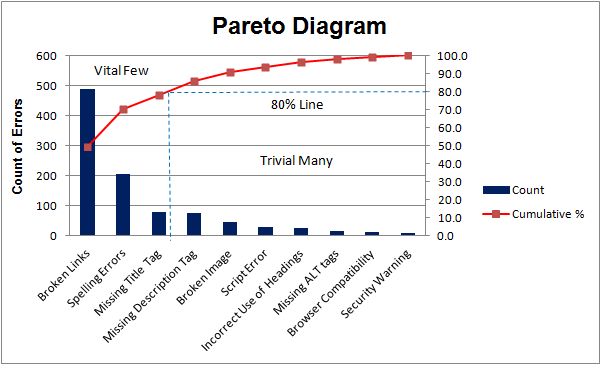
Did you ever have the feeling that your efforts don’t bring results as expected? Do some of your team’s activities remind you of the proverbial mountain that brought forth a mouse? Do you sometimes doubt your efficiency at planning and performing work?
The reason behind this is somewhat counterintuitive: there’s no direct proportion between efforts applied and results yielded.
The actual proportion is described by the Pareto principle: 20% of your efforts bring 80% of your results. While this is not the exact number – just an approximate proportion for reference – it gives an idea of how you can maximize the outcome of your activities.
The vital few and the trivial many
The Pareto principle can apply to almost any area of activity. Below are some examples of shapes it takes in different fields and business areas.
- In customer service: 80% of customers’ complaints are associated with 20% of offered products or services;
- In team management: 80% of schedule changes are caused by 20% of the possible reasons;
- In product management: 20% of products and services bring 80% of total revenue;
- In risk management: 20% of hazards account for 80% of accidents;
- In sales: 20% of clients bring 80% of profit;
- In project management: 20% of workforce perform 80% of project work;
- In software development: 20% of bugs and errors cause 80% of crashes.
The first thoughts this proportion invites are seemingly reasonable questions. Can I only work 20% of time if that accounts for 80% of my outcome? Why not fire those 80% slackers whose work scope only amounts to 20%? What if we put 80% of QA work on the back burner and save resources?
No, that’s not a good idea.
The truth is, both sides of this proportion are important. The “vital few” 20% is the part you need to focus on in the first place. But this doesn’t mean simply ignoring the “trivial many” 80%: this would undermine the quality of your work, and reduce its value. Smaller details and issues don’t need to get addressed as soon as possible, but they are important for work quality, customer retention, and job satisfaction.

Using the 80/20 proportion in decision making
Decision making is often depicted as an intuitive process, but you can – and need – to back it with scientific facts. Knowing the Pareto proportion, it’s easier to define parts of work that need closer attention, more resources, or stricter deadlines. Here’s what you as a decision maker need to take into account when planning and managing work.
20% of your work defines 80% of results. Taking this into account, you need to:
- Identify the 20% of work tasks that build up 80% of the outcome;
- Tackle the crucial 20% of tasks first;
- Prioritize the remaining 80% so that it gets accomplished on time.
20% of your team is performing 80% of work. This means that you need to:
- Identify top performers on your team;
- Distribute workloads evenly to prevent top performers from being overloaded;
- Assign crucial work to top performers;
- Delegate your own work, including decision making tasks;
- Consider dividing your team into smaller groups and distributing work between them.
20% of issues bring 80% of conflicts and dissatisfaction. According to this, you need to:
- Collect feedback on possible issues from your team or your customers, and keep record of it;
- Identify the top reported 20% of issues, and address them first;
- Make sure the remaining 80% of issues don’t remain unaddressed.
20% of your efforts bring 80% of the results. This doesn’t mean you can work just 1/5 of your regular work hours – it means you’re being most productive only 20% of your time. And here’s what you can do to be more efficient and make better decisions:
- Figure out what part of your work time is the most productive;
- Use the most productive time to tackle urgent and crucial tasks;
- Be mindful about the remaining 80%, and use productivity improvement techniques to get more value of it.
Summary
The Pareto principle, while being just an approximation, is a good basis for making intelligent decisions. It allows you to build a decision-making process that is focused on crucial factors and ensures better outcome. Decisions made on the basis of the Pareto analysis allow managers to distribute time and resources more mindfully, which contributes to high quality of work, customer satisfaction, and general success.











































